Who wouldn’t want to be able to grow your own chocolate? When you grow a cacao tree, you can get many of the cocoa products you see in stores today. Theobroma cacao is definitely a true tropical tree. Like other tropical plants, cocoa likes humidity, heat, and all the things that most climates in the continental US just don’t have. But that doesn’t mean it’s entirely impossible to grow it here.
In parts of Florida and Hawaii, cacao can be grown outdoors. In other areas, it’s possible to grow cacao in a greenhouse. Similarly, people have managed to grow it in Mexico, and there are cacao trees at most botanical gardens along the west coast of the US (although they often are in large enclosed greenhouse spaces with higher humidity than outside).
What’s more rewarding than growing your own chocolate, though? Although, cocoa is not your typical houseplant. It has very specific requirements. This species will take some serious preparation, a lot of love, and creativity to grow well. But oh, will it be worth it in the end. For anyone who loves to eat chocolate and also loves to garden, growing your own cacao tree is the ultimate cross-over!
Good Products At Amazon For Growing Cacao Trees:
Quick Care Guide

| Common Name(s) | Food of the gods, cacao tree, cocoa |
| Scientific Name | Theobroma cacao |
| Days to Harvest | When started from seed, it can take up to 5 years for a cacao tree to produce pods |
| Light | Full sun to partial shade |
| Water | 1-2 inches of water per week |
| Soil | well-draining soil |
| Fertilizer | Organic matter, well-balanced fertilizer |
| Pests | Cocoa pod borer |
| Diseases | Frosty pod rot, swollen shoot, black pod rot, witches broom |
All About The Cacao Tree

Theobroma cacao is an evergreen tree in the Malvaceae family or mallow family which also include plants like cotton, okra, durian, and hollyhock. The cocoa plant is also known as the cacao plant, cocoa tree, and food of the gods. More than half of the world’s cocoa comes from only two countries, where the tree is native: the Ivory Coast and Ghana. Most of the cocoa pods grown in the United States are grown in Hawaii. It is thought that cacao trees originated long ago in the upper Amazon region of modern-day South America, in Peru, Ecuador, and Colombia. Its native range stretches from southern Mexico, Central America, and South America.
Cacao trees have rich green leaves and can grow up to 30 feet tall, with branches reaching the same distance horizontally. In their natural habitat, they are generally a part of the understory ground floor of a tropical rainforest. Cocoa trees, therefore, like shade. The flowers grow in clusters directly from the trunk giving them a very unique appearance once the pods begin to form. Clusters of football-shaped yellow-orange pods form jut out from the trunk rather than the branches.
Within the pods fruit develop, containing the cocoa bean everyone knows and loves. Cocoa plants have shallow roots. These and the tree’s branches require protection from strong winds which it receives naturally in the understory. Cacao flowers are strictly entomophilous pollinated, so they rely on insects for pollination. In its native range the cocoa midge, a small mosquito, is the main insect pollinator of cacao trees. Pollination by these insects is required for cocoa plants to set fruit in the wild.
The three most popular varieties of cacao crops (known as cocoa when processed) used for cocoa production by cacao farmers are Criollo, Forastero, and Trinitario trees. Trinitario is a hybrid species of Forastero and Criollo.
From cacao beans within the pods, you can get cocoa powder, chocolate liquor, and butter. White chocolate contains cocoa butter, but no chocolate liquor, which gives it a white color. Dark chocolate contains both cocoa butter and chocolate liquor. Dark chocolate also generally has a lower sugar content which can leave a slightly bitter flavor as compared to milk chocolate (which has the addition of milk solids as well).
The Royal Botanic Gardens of Sydney recently added a cocoa tree to their famous glasshouse. Now people from all over the world can visit to see the cocoa pods and cacao beans that grow from the branches of this lovely tropical cocoa tree from South America. This is beneficial because climate change has made growing cocoa trees more difficult.
Planting

Cacao can be grown from seeds and is an extremely quick grower. Within the first 30 days after the seeds sprout, the trees planted can reach a foot tall. However, like with most fruiting trees, it takes approximately 5 years of flowers for the tree to reach maturity and begin to set fruits. The young leaves on cocoa plants will appear reddish at first, with red veins, and slowly begin to turn green. Since cacao trees prefer hot and humid tropical climates there are few areas in the United States where they can be grown outside of a greenhouse. The seeds within the fruit are large and the outer white pulp needs to be peeled away from the seed before planting. Plant the seed at a depth at least two times the size of the bean. Keep even moisture and seat in a hot and humid environment. Your seed should sprout within a week.
Care
Cacao trees are fast growers that can thrive given the right conditions. Read on to learn about its specific requirements.
Sun and Temperature
Cacao plants with their green foliage can survive in full sun to part shade. However, in their natural environment, they grow in the understory and thus can survive with as little as 3 hours of direct sunlight per day. It can be grown outdoors in USDA growing zones 11-13. It is extremely sensitive to frost/freeze, and its ideal temperature range is 65-90 degrees Fahrenheit. Additionally, temperatures above 90 degrees can slow the plant’s overall growth rate and can cause flowers to drop, and fruits will fail to form. There isn’t really a good way to protect this plant from the cold other than to avoid growing it in cold regions! For this reason, greenhouse growing is a great option where their specific temperature needs can be met.
Water and Humidity
Cacao trees thrive in hot and humid environments. In their native range of tropical rainforests, their green foliage regularly receives rainfall and moisture. Be sure to water your cacao tree deeply at least once a week. You will get the most production of fruits by giving your plant 1-2 inches of water per week. A slow drenching of the soil works best. Creating a humid environment will help keep the soil moist and prevent it from drying out too quickly.

Soil
Cacao trees require loamy, moisture-retentive, well-draining media. A mixture of potting soil and peat moss or coco coir will help keep the soil evenly moist. This tree can survive in a variety of soil pHs, but it does best with slightly acidic soil. Prior to planting, amend the top 4-8 inches of soil with plenty of compost and organic matter. Then mulch around the base of the tree with a wood chip mulch, keeping the layer away from the tree’s trunk.
Fertilizing
Fertilize young trees two times per year, once in spring, and again in the fall. Use a well-balanced fertilizer slightly higher in nitrogen to help boost the growth of a young plant. Once the cacao tree reaches maturity, back off of the nitrogen fertilizer. Nitrogen promotes the plant growth of foliage, but at this point you want your tree to focus on forming flowers and fruits.
Pruning
Cacao trees can grow 20-30 ft above the ground. Once it grows a 5-6 ft tall trunk it will begin to branch out. This is the perfect time to begin pruning and shaping to control overall shape and height if you’d like, but pruning is not at all necessary.
Propagation
Cacao can be propagated via stem cuttings. When taking a cutting be sure to cut a section growing from the trunk that has about 5 leaves, and 1-2 flower buds. Place the cutting in a glass of water until tiny white roots form (within about a week). Once the roots have formed, you can place the cutting directly into the soil. Your new cacao tree should be established within a few weeks.
Harvesting and Storing

Now for the fun part of growing cacao: harvesting your chocolate! OR soon-to-be chocolate depending on how you choose to process your cacao beans.
Harvesting
The cacao pod will start out green and ripen to an orangey-yellow color. It’s important to harvest the pod at the right time when it is ripe and progresses beyond a yellow hue. If you wait too long the seeds inside can begin to sprout before they are planted. You’ll know the pod is ripe when the color begins to deepen into an orange or red (depending on the variety) and if you shake the pod, you will hear the beans rattle inside. Each pod can contain up to 50 cocoa beans. Break open the pod with a hammer or mallet to remove the beans. Each bean will be surrounded by a white pulp. The beans then generally undergo a fermentation process before they are stored.
Storing
The raw cacao beans have a citrusy flavor and can be eaten as is, or roasted. However, as mentioned above, they usually go through a fermentation process before being processed into various chocolate products. The fermentation process occurs naturally due to the yeasts that surround the outer white pulp. The beans are left outdoors, spread in a single layer, to ferment for 6-10 days. The beans will slowly go from white to purple to red when they are fully fermented. They are then dried and can be stored for future use at this point. Freshly harvested beans can be stored pre-fermentation for a short period of time in refrigeration for up to a week.
Troubleshooting
Growing your own chocolate is an exciting adventure, but there are a few challenges to consider. Read on to learn how to troubleshoot potential problems with growing cacao.
Growing Problems
Most growing problems stem from the cocoa plant’s temperature and humidity requirements not being met. If you notice leaves or yellow flowers turning brown and or dropping, this is an indication that the air’s moisture needs to be increased. Growing cacao successfully requires mimicking the conditions of high humidity and warm rainforest.
Pests
The pod borer targets the cacao pods of these trees and is the most common pest for commercially grown cocoa trees. As its name would suggest, this is an insect that tunnels into leaves, stems, and fruit. Exit holes from the larvae on the pods and uneven ripening of the pods are symptoms of this pest. Pyrethrin-based organic insecticides applied as a foliar spray are the best method to rid your cacao of the cacao pod borer.
Diseases
Cocoa pod rot is caused by a fungus and is one of the most destructive diseases to affect cacao trees. It causes lesions on the pods, and they begin to rot. It can reduce the plant’s production by 80% in just a few years. Another fungus, Phytophthora palmivora, can cause black pod rot which manifests with similar symptoms. Copper fungicides have been found to successfully control these fungal issues.
The swollen shoot is a virus that can kill cacao trees within a few years. It has been particularly destructive in West Africa. Symptoms include leaf discoloration and stem/shoot swelling. This virus is mainly transmitted by mealybugs, so controlling their population will help avoid this issue.
Witches broom is caused by the fungal pathogen, Moniliophthora perniciosa. Signs of this disease include unhealthy clustering of new shoots and a reduction of the tree’s vigor. Prune affected parts of the tree. Remove the entire tree and burn it if the pruning doesn’t lessen the issue.
Frequently Asked Questions

Q: Can I grow a cacao tree?
A: Yes! They can be grown indoors in a container and do best in a warm, high humidity environment such as a greenhouse. Try the Air Pots we sell in our shop.
Q: Can you grow cacao in the US?
A: Yes, most cacao grown in the United States is grown in Hawaii, but it has also been grown in places like Florida and can be found in botanical gardens across the Western states.
Q: How long does a cacao tree take to grow?
A: It takes 5 years from seed to maturity. Around the 5-year mark, the cacao tree will begin to set fruit.
Q: How long is a cacao tree life span?
A: Cacao trees can live for up to 100 years.
Q: Is cacao fruit edible?
A: It is edible in its raw form and has been described as tasting citrusy like lime.














